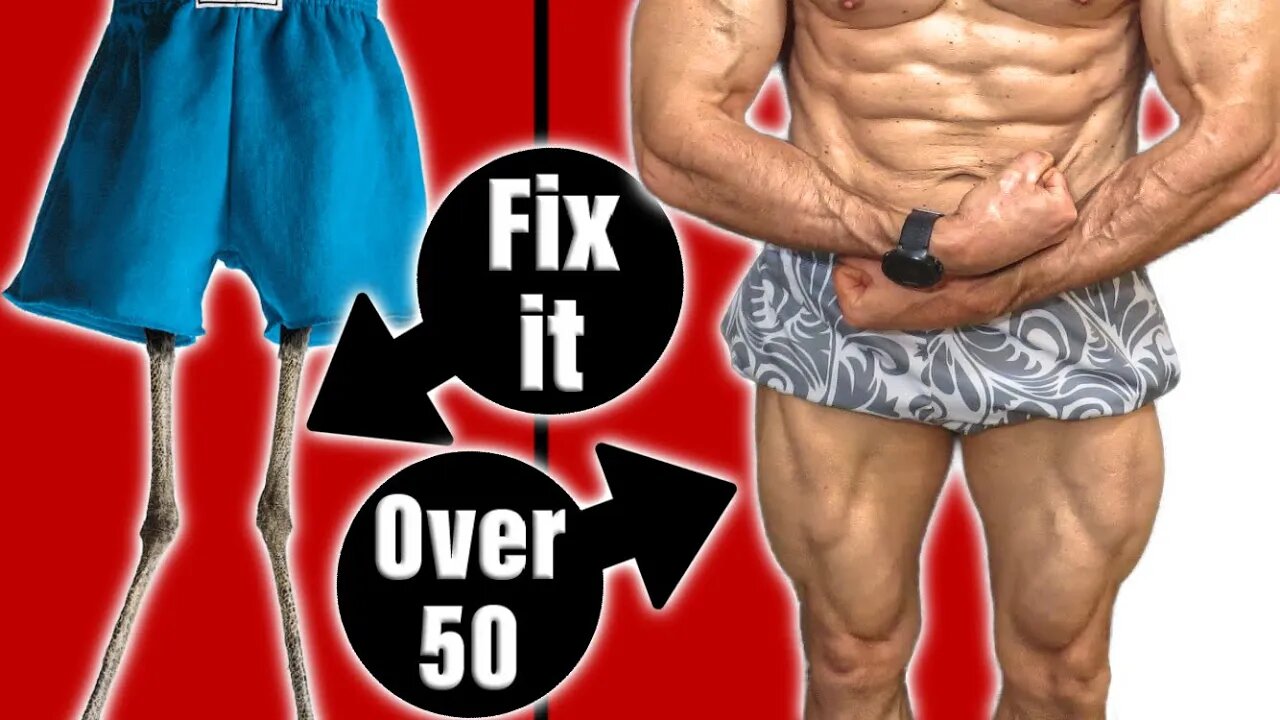Premium Only Content

Why You Should Never Skip Leg Day Over 50 (It Starts At 30)
Why You Should Never Skip Leg Day Over 50 (it starts at 30)
It starts in our 30’s and gets even worse in our 40’s. When we think of leg day, we think of building muscle, but skipping legs negatively affects more than just muscle mass. It affects bone density, joint health, and even our mobility and stability.
Inactive people get hit the worst losing between 3 to 8% of their muscle mass every 10 years after the age of 30. The best way to stop or reverse this trend is leg training.
And I get it. Training legs is hard. I’m a runner, and I often used running as an excuse to get out of leg day. Over the last two years, I’ve gotten serious about my leg training and, especially over the last year; I’ve made noticeable progress.
To get the most out of our leg training, we need to progressively work all the muscles of our leg, including quads, hamstrings, calves and I include glutes.
If you are interested in losing body fat and adding muscle, please email me at 1shark1bite@gmail.com for information on my personal training services.
Here is the link to FortisFight https://www.fortisfight.com/product-category/men/ and use my affiliate discount code FITAND50 at checkout for 15% off you next purchase on all of their apparel.
If you would like a set of Torrobands for yourself, here is my affiliate link so you can receive 50% off on your purchase https://sale.torroband.com/?affId=555B3E5D
Check your testosterone levels from home. Just click this link http://trylgc.com/laurence and receive 20% off with code: LAURENCE20 I receive commissions on referrals to LetsGetChecked. I only recommend services I know and trust.
My Affiliate link to Lebert for their Equalizer bars and more; https://lebertfitness.com/?ref=FitAnd50 and use the discount code FITAND50 you will receive 20% off your purchase
Facebook; https://www.facebook.com/Fit-and-50-5...
My Amazon page link; https://www.amazon.com/shop/fitand50
Anytime you’re trying to build muscle, nutrition plays a role. If you’re leaner, you need to be in a slight calorie surplus. If you have a fair bit of weight to lose, you can be in a calorie deficit and still build muscle just don’t make the cut too extreme.
Eating enough protein is essential if we expect to see leg gains. I like the recommendation of keeping our protein between 30 and 35% of our total calories. For those who prefer grams per pound, your intake should be over .72g per pound of goal bodyweight.
We can start losing bone density as early as our 40s, which is a genuine concern. The leading cause of injury-related deaths over 65 is falling. Breaking a hip or femur is serious, especially as we get older. Three ways we can help prevent this is improving leg strength, bone density and balance.
Resistance workouts are a great low-impact way to improve our bone density. The force of the muscle pulling on the bone is enough to stimulate bone growth.
Heavy compound movements work the best. One study found after 24 wks using undulating periodization to vary the resistance between 68 and 95% of their one-rep max resulted in between, 2.7 to 7.7 percent increase in bone mineral density
In this study, they used a wide variety of exercises that incorporated the whole body. For the legs, they used squats, stiff-legged deadlifts, and seated heel raise or calf raises.
Unilateral leg training helps us not only build strength but improve balance. Starting with a split squat, gradually advancing the movement to a reverse lunge and then moving on to the Bulgarian split squat. Each step of the way, challenging and improving our balance.
Leg training helps with knee pain by adding muscle around the joint, providing stability and working as a shock absorber reducing the impact on the knee.
I looked at a review of 8 studies using older adults, including some with osteoarthritis, and it found strength training reduced pain by 35%.
This doesn’t have to be extremely high intensity to reap the benefit either. One study they reviewed intended on using 80% of the test subjects one rep max. The participants found it too painful, so they reduced the intensity to 60% for 3 sets of 8 reps and compared this to another group that only used 10% of their max for 10 sets of 15 repetitions.
Both groups reduced pain and improved function with no significant difference between them.
One of insulin's jobs is to slow muscle breakdown. They did a study comparing muscle breakdown in the legs of a group of older people to that of younger ones. And found two things, one that insulin was less effective at reducing muscle breakdown in older adults and that blood flow to the legs was substantially reduced.
https://www.sciencedaily.com/releases/2009/09/090911103807.htm
https://academic.oup.com/ajcn/article/90/5/1343/4598139
https://pubmed.ncbi.nlm.nih.gov/20647940/
https://journals.lww.com/nsca-jscr/Fulltext/2011/04000/Changes_in_Bone_Mineral_Density_in_Response_to_24.30.aspx
https://www.ncbi.nlm.nih.gov/pmc/articles/PMC3606891/
-
 4:57
4:57
Fit and 50
1 year ago $0.08 earnedBuild Full Body Muscle at Home With Dumbbells Over 50 (Real Growth)
3751 -
 2:23:15
2:23:15
Nerdrotic
8 hours ago $10.10 earnedA Very Merry Christmas | FNT Square Up - Nerdrotic Nooner 453
67.4K5 -
 1:14:05
1:14:05
Tucker Carlson
8 hours ago“I’ll Win With or Without You,” Teamsters Union President Reveals Kamala Harris’s Famous Last Words
150K290 -
 1:58:31
1:58:31
The Dilley Show
8 hours ago $30.88 earnedTrump Conquering Western Hemisphere? w/Author Brenden Dilley 12/23/2024
125K31 -
 1:09:59
1:09:59
Geeks + Gamers
9 hours agoSonic 3 DESTROYS Mufasa And Disney, Naughty Dog Actress SLAMS Gamers Over Intergalactic
83.7K20 -
 51:59
51:59
The Dan Bongino Show
10 hours agoDemocrat Donor Admits The Scary Truth (Ep. 2393) - 12/23/2024
807K2.58K -
 2:32:15
2:32:15
Matt Kohrs
21 hours agoRumble CEO Chris Pavlovski Talks $775M Tether Partnership || The MK Show
121K31 -
 28:23
28:23
Dave Portnoy
21 hours agoDavey Day Trader Presented by Kraken - December 23, 2024
155K42 -
 59:29
59:29
BonginoReport
12 hours agoTrump, Murder Plots, and the Christmas Miracle: Evita + Jack Posobiec (Ep.110) - 12/23/2024
161K130 -
 2:59:14
2:59:14
Wendy Bell Radio
14 hours agoNothing To See Here
129K74